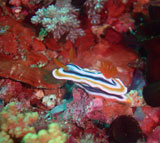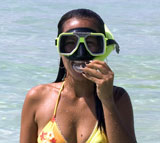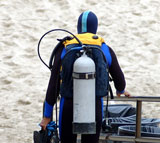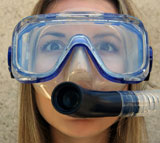Diving Physics
by Conrad H. Blickenstorfer
If you clicked on the link to this page, you are a brave soul, and also a smart one. The term "physics" is intimidating to most people. It can even be intimidating to highly educated people. Heck, most physics is taught in highschool and college, and even folks with advanced degrees quickly forget most school knowledge and concentrate on what really matters in life. Should you actually be a physicist, apologies. You can skip this page, though probably even you shouldn't.
So why are "physics' part of every diving class curriculum? That's because the sport of diving involves dealing with an environment that is not natural to us humans. Sure we take showers and bathe and swim (and at some point all mammals emerged from the oceans], but actually being underwater,
that's a different thing altogether. We cannot breathe underwater. Water is fundamentally different from air. And if we do not understand the entirely different rules of being, and surviving, underwater, diving can be dangerous or even deadly.
What's so different you might ask. Just take a tank of compressed air with you and you're all set. Not so. Underwater, everything is different. Our senses work differently. We see differently because of the optics of water. We hear differently because sound travels much faster. There is the drag of water and the fact that the laws of gravity no longer seem to apply the way we instinctively know them on dry land. Colors are different because some of them are absorbed by water very differently than by air. Water is a much better conductor of heat than air is. As a result, we lose heat much more quickly in cold water. Most importantly, though, water is much, much denser than air. At sea level, water weighs about 800 times more than air. Which means that as you dive, you are quickly subjected to very substantial pressure. Since the human body consists mostly of water, you're in no danger
of being crushed. However the gasses inside the human body are greatly affected. They get compressed a great deal the deeper you dive, and the impact of that is the most important reason why any diver must be aware of the physics of being underwater.
So let's get started with the physics lessons. We'll keep it simple, but do realize that some of those laws are based on rather complex equations. You do not need to understand every part of every law or equation, but you must understand what it all means to you and your body when you are underwater. So let's get started!
Buoyancy
The dictionary describes buoyancy, as far as it applies to being in or under water, as "the tendency or capacity to remain afloat in a liquid." That phenomenon is based on something first discovered by the ancient Greek scientist Archimedes, who lived over 2,200 years ago. What he found was that an object that
is partly or fully immersed in water is pushed up by a force equal to the weight of the fluid displaced. That, obviously, is of significant importance to divers. In diver speak, "neutral buoyancy" means you (your body and whatever gear you have on you) is exactly as dense as the water. Applying Archimedes' finding, that means you just float in place and neither rise nor sink. If the sum total of your body is less dense than the surrounding water, you are "positively buoyant" and you rise. If you and your gear are denser than the water, you are "negatively buoyant," and you sink. So if you ever thought diving simply meant swimming down or coming back up, not so. Proper diving means you constantly have to control your buoyancy.
How does one control one's buoyancy? There are three major ways. The first is by adding weights. Those can be attached to the diver's body in various ways. As a rule of thumb, they generally amount to about 10% of body weight. The second way is by using the Buoyancy Compensator (BC), also called a Buoyancy Control Device (BCD). The BC gets its air from the scuba tank and is used to adjust buoyancy at various depths. It is, of course, also a safety device, should a diver need to
ascend quickly. The third, and (for beginners) least effective, buoyancy control is your lungs. Most people are positively buoyant in water with their lungs full of air, but negatively buoyant once they breathe out.
Keep in mind that overall buoyancy depends on a lot of things: The size and weight of the diver, the type of diving suit, the weight belt, the design and weight of the scuba unit, the air in the BC, the air in your lungs, the remaining air in the tank, all the stuff you carry with you, and also whether you are diving in fresh or salt water. Salt water contains dissolved minerals, mostly salt. In fact, we're talking about around 30 to 35 pounds of salt in a thousand pounds of water, which means seawater is denser and thus exerts a bit more upward buoyancy onto your body.
Gassy matters
When it comes to diving, gasses and the way they behave have nothing to do with the sophomoric humor so heartily enjoyed by younger audiences. In fact, the behavior of gasses at the pressures encountered underwater becomes a very important, very serious matter. If not properly understood and respected,
they can become a matter of life and death.
The major issue here is that gasses are very low density compared to water. For all practical purposes, water does not compress at all, even at the bottom of the ocean (well, it does, but not enough to matter for diving). Gas, on the other hand, can easily be compressed, and things happen when it does. That is why it is essential to have a basic understanding of the laws that govern the behavior of gas.
Now what are we concerned about? Is it just air in general, or the different components of air? Both. What we call "air" actually consists of a number of gasses but two make up almost all of it.
The first is oxygen. Scientists know it as a chemical element in the periodic table that lists all chemical elements known to man. It is known by the symbol "O" and carries the atomic number 8. Oxygen is the second most common element on earth and makes up about 21% of the air we breathe. Oxygen easily bonds with other elements and thus carries nutrients around our body and thus enables life. Oxygen easily bonds with virtually all other elements, which makes it a tremendously useful element. Of course, it's also the reason why things rust, and too much oxygen can actually be poisonous for the human body. We'll get to that later.
The second is nitrogen, another element in the period table, carrying the letter "N" and the atomic number 7. Nitrogen is by far the largest component of our air, 78%. In the human body it doesn't really do anything. Above water, whatever nitrogen we breathe in, we also breathe out. Some nitrogen gets absorbed by our bodies and just stays there.
The remaining one percent of gas in the air consists of a variety of elements such as Argon, Neon, Helium, Methane, Krypton, Hydrogen, Carbon dioxide and others. With the exception of Carbon dioxide, those trace gasses don't matter when
you're diving.
Oxygen and nitrogen, however, do matter. Oxygen, because you need it to live. And Nitrogen because it can do bad things to your body. The effects of nitrogen are, in fact, the primary reason why divers must known about the physics of gasses.
The problem with Nitrogen
So what makes nitrogen a bad guy? The problem is that when you dive, the increased pressure of the water compresses nitrogen and more of it dissolves into your body. Just as there is a natural nitrogen saturation point at the surface, there are saturation points under water. Those depend on the depth, the type of body tissue involved, and also how long a diver is exposed to the extra pressure. The deeper you dive, the more nitrogen your body absorbs. Worse, the deeper you go, the larger the difference between the nitrogen already absorbed in your body and what it now can hold, which means more nitrogen gets absorbed ever faster. Absorbing nitrogen is not really the problem, at least not to a certain point (if you dive deeper than 100 feet or so, nitrogen can result in nitrogen narcosis - more on that later).
The problem is getting rid of the nitrogen once you ascend again. As the pressure diminishes, nitrogen starts dissolving out of the tissues of the diver's body, a process called "off-gassing." That results in tiny nitrogen bubbles that then get carried to the lungs and breathed out. However, if there is too much nitrogen
and/or it is released too quickly, small bubbles can combine to form larger bubbles, and those can do damage to the body, anything from minor discomforts all the way to major problems and even death.
This is why divers must know the behavior of gasses under pressure, and this is why diving instruments are absolutely essential. And why there are
"dive tables" that calculate how much nitrogen is absorbed and can safely be released.
[Click for an explanation of Dive Tables]
Nitrogen off-gassing is an exceedingly complex issue that currently still only relies on models and approximations derived from decades of observation and testing. And as if the underlying physics were not complex enough, each individual diver is different and will absorb and release nitrogen in a different way. Different body tissues, for example, have widely differing absorption/diffusion properties. Cartilage and bone are very slow to absorb and release nitrogen, lung tissue very fast. Body fat, which very widely varies among individuals, has a much greater affinity for nitrogen absorption and can thus impact decompression significantly.
The Gas Laws
With all of the above in mind, I hope you're now ready for some of the laws governing the behavior of gasses. Those laws are generally named after the people who discovered them, so you'll learn about Boyle's law and those of monsieurs Charles, Dalton, and Henry. So here we go:
Sir Robert Boyle's law says that as gas pressure increases, gas volume decreases.
Jacques Charles' law says that with constant pressure, gas volume increases and decreases with its temperature.
John Dalton added that in a mix of gasses, the total gas pressure is equal to the sum of their individual pressures.
William Henry, finally, figured that the amount of gas that will dissolve in a liquid is a function of its partial pressure and how easily the liquid absorbs gas.
Now why are those laws important to divers?
Boyle's law describes how gas gets compressed as pressure increases. Pressure is measured in many units, but for simplicity's sake, let's use atmospheres. One atmosphere is the air pressure at sea level. One atmosphere also translates into 14.7 pounds per square inch, or 14.7 psi. At a depth of 33 feet in the water, the pressure doubles, which means gas down there is compressed to half its volume. And every regular breath of air actually takes in twice as many air molecules as on the surface. That means the air in the tank only lasts half as long. For each additional 33 feet of depth, the pressure increases by another atmosphere. So the total pressure at 33 feet is two atmospheres, at 66 feet three atmospheres, and so on. At a depth of a hundred feet, the pressure is four atmospheres, and the air in the tank only lasts a quarter of the time it would on the surface.
And here's why Boyle's law comes first: Imagine taking a breath of air at a
depth of 33 feet, then holding your breath and ascending to the surface. The
air will expand to twice its size, which can lead to abnormal presence of air
around the lungs ("pneumothorax"), which can result in the collapse of the
lung and other nasty things. It can also lead to Arterial Air Embolism, a dangerous condition where air bubbles make it into the bloodstream and cause blockages. Or something called Mediastinal Emphysima, which means air trapped in the center of the chest. Finally, air bubbles can get under the surface of the skin, causing subcutaneous emphysima--not pleasant. So Boyle's law directly demands the most important rule of scuba
safety:
Never hold your breath
when you scuba dive!
Charles' law describes why a scuba cylinder being filled with air gets quite hot (ever noticed how a bicycle pump gets hot when you use it?). So it's nicely filled at the dive shop, but once it cools down you see that the pressure inside the tank is now much lower. That's because gas pressure gets lower when the gas gets cooler.
Dalton's law explains how the partial pressures of individual gasses make up the whole pressure. So the ratio between the gasses remains the same, but since they are compressed, they may do damage. For example, if a bad compressor pumps some carbon monoxide into the tank, at the surface that would not do much damage, but at depth the amount of carbon monoxide inhaled could become deadly. Why is that? Because while the percentage of carbon monoxide stays the same, at,
say, 100 feet we'd still breathe in four times as many carbon monoxide molecules--enought to do damage. Likewise, normally safe gasses like oxygen can become toxic under great pressure.
Henry's law is extremely important as it describes how gas gets absorbed in liquids under pressure. The problem is that the various tissues in the human body absorb and release gasses at different rates. And people also come in all sizes and shapes. That means that it is extremely difficult to accurately predict "ingassing" and the much more dangerous "outgassing" into and out of tissue. Dive tables, and more recently dive computers, contain data that shows safe rates of ascent, but they are all based on numerous assumptions. As a result, there are different algorithms, all of which are likely to err on the side of caution.
Gas law table
The table below illustrates the impact of Boyle's and Dalton's laws on air pressure and density. Note that the sport diving limit is around 130 feet. At that depth you're subjected to a total pressure of five atmospheres, and the air in your tank has been compressed to 1/5th of its volume. Which means it only lasts 1/5th as long. And when you look at the partial pressures of Nitrogen and Oxygen as you dive deeper, you can see how Henry's law will make a lot of Nitrogen dissolve into your body tissues.
| Depth (feet) sea/fresh water |
Atm. |
PSI |
Volume |
Density |
Nitrogen
(78%) |
Oxygen
(20.9%) |
Air volume CuFt |
| Sea level |
1 |
14.7 |
1 |
1 |
11.47 |
2.94 |
10.00 |
| 33/34 |
2 |
29.4 |
1/2 |
2x |
22.93 |
5.88 |
5.00 |
| 66/68 |
3 |
44.1 |
1/3 |
3x |
34.40 |
8.82 |
3.33 |
| 99/102 |
4 |
58.8 |
1/4 |
4x |
45.86 |
11.76 |
2.50 |
| 132/136 |
5 |
73.5 |
1/5 |
5x |
57.33 |
14.70 |
2.00 |
| 165/170 |
6 |
88.2 |
1/6 |
6x |
68.8 |
17.64 |
1.66 |
| 198/204 |
7 |
102.9 |
1/7 |
7x |
80.26 |
20.58 |
1.43 |
| 231/238 |
8 |
117.6 |
1/8 |
8x |
91.73 |
23.52 |
1.25 |
| 264/272 |
9 |
132.3 |
1/9 |
9x |
103.19 |
26.46 |
1.11 |
| 297/306 |
10 |
147.0 |
1/10 |
10x |
114.66 |
29.40 |
1.00 |
(Table data from diving instructor Carol Cotton Walker's NAUI certification course at Rhea's Diving Services, Inc., in Maryville, Tennessee.)
High altitude diving
When you dive, you're dealing with two kinds of pressure. One is the varying
pressure under water, while you dive. The other is the air pressure once you
are back at the surface. The dive tables assume that pressure to be
sea-level air pressure, and the surface interval times and their impact on
nitrogen release are based on that assumption. But what if you dive at
higher elevations? The PADI Recreational Dive Planner warns that diving
above altitudes of 1,000 feet requires special considerations. There are
several.
For example, if you start out at sea level and then drive up a mountain to
dive in a mountain like, such as Lake Tahoe which is at 6,200 feet, you
start out having residual nitrogen in your body, and your first dive must be
treated as a repetitive dive, unless you wait long enough for your body to
first totally adjust to the new altitude.
Further, while water weighs the same at altitude than at sea
level (except for the small difference between saltwater and sweet water) and the extra pressure exerted on your body by, say, 66 feet of water
is the same as at sea level, once you get out of the water, the air pressure
is lower. Which means the pressure ratio between your deepest depth
and the surface is larger at higher elevations than it would be if you did a dive to the same depth at sea level. To be safe, you must calculate what ocean depth would result in the same depth-to-surface pressure ratio as your altitude depth, and then use that theoretical depth to determine your maximum no-decompression limit. There are altitude adjustment tables where you can look up the theoretical depths for different altitudes. For examples of high altitude adjustment tables, click
here or here.
When using the PADI system, you may assume that each 1,000 feet of
additional elevation is equivalent of two pressure groups. And, as always,
you round up. So an elevation of 7,200 feet would be treated as 8,000 feet.
Additionally, your maximum ascent should be slower. PADI recommends 30 feet per minute as opposed to a maximum of 60 feet per minute at sea level.
Light and vision
We see differently underwater, and the reason, once again, is physics. The
diving mask itself, with its flat glass lens or lenses, bends light so that
objects underwater are magnified by about a third. I say "about" because the
magnification factor depends both on how far the lenses are from the eyes,
and also how far away an object is. For some reason, inexperienced divers tend
to underestimate the distance of close objects, and overestimate the
distance to objects farther away. There are special diving masks that
attempt to eliminate this distortion, but they have their drawbacks and
require getting used to.
Colors are different underwater as well. Colors are really nothing more than
different wavelengths reflected by an object. Underwater, waves travel
differently, and some wavelengths are filtered out by water sooner than
others. Lower energy waves are absorbed first, so red disappears first, then
orange, then yellow. Green stays longer and blue the longest, which is why
things look bluer the deeper you go. As long as the water is clear, that is.
In murky water there is less light penetration and things tend to look
greenish-yellow.
Even under the best conditions, colors can only be seen down to a depth of a
bit over 100 feet. Below that things look black or gray. The way colors are
absorbed has an impact on underwater photography: a good light source is
needed for vibrant images.
But wait, there's more. Or rather, less. See, the water surface is reflective and can act a bit like a mirror. At high noon, with the sun being right overhead, that's no big deal and almost all of the sun's light enters the water. However, early and late in the day when the sun's rays hit the water at shallow angles, almost all light is reflected away and doesn't make it into the water. So be aware that it can get dark sooner than you think.
Sound
Sound travels much faster in water than in the air, about four times as
fast. Sounds also travels farther in the water. (This is why the military is
so concerned about having silent submarines.) And sound underwater is
affected by pressure, water temperature, and salinity. This can produce
interesting results when underwater sound meets two layers of water with
different temperatures.
All this means that our hearing, which is designed to interpret sound in the
air, can easily get confused underwater. Our brain detects the source, and
to some extent the distance, of a
sound by the difference between its arrival in the right and left ear. With
underwater sound so much faster, our brain cannot process direction easily,
and underwater sound often comes across as being all around a diver.
Heat loss in water
If you've ever noticed that you feel perfectly comfortable walking around at 68 degrees Fahrenheit, but water of the same temperature feels pretty cold quickly, it's because water is a much better conductor of heat than air. So on land, the roughly 30 degree difference between air temperature and your body temperature is no big deal. However, when diving, the water that comes in contact with your body warms up, expands, and quickly
carries the heat away from you. As a result, you feel cold in no time. In fact,
water removes heat from your body between 25 and 40 times faster than
air!
Another reason for greater heat loss when diving is breathing. Breathing
generally accounts for about a quarter of our body's heat loss in the form
of exhaled warm air. The deeper we dive, the denser the air we inhale. At a
depth of 33 feet the air we breathe in and exhale is already twice as dense
as on the surface, which means that the heat loss from exhaling is twice as
large as well.
This accelerated heat loss is why divers wear "exposure suits," diving suits that are either sealed drysuits
that do not allow any water in, or wetsuits where some water gets in. Drysuits work by using a thin layer of air in addition to the insulating properties of the suit. In wetsuits, a thin layer of water that's been warmed up by your body does the same. Unfortunately, underwater physics throw divers another curve: the increasing pressure compresses the insulating gas bubbles inside the exposure suit, making it ever less effective the deeper you go. That's why there are recommendations as to what type and thickness of suit you should wear at different water temperatures.
Portuguese translation of this page by Artur Weber: Física de mergulho
|










